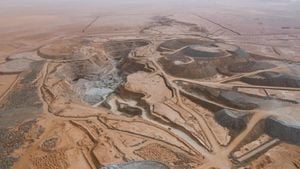Spain is currently grappling with its worst flooding disaster in decades, as torrential rains have been wreaking havoc across the eastern and southern regions. With at least 158 confirmed deaths, including 155 just from the Valencia area, the nation stands on the brink of national tragedy. Thousands are trapped, and emergency rescue efforts continue vigorously as families are being pulled from their homes where furious waters have left damage of catastrophic proportions.
The flooding spike struck suddenly on Tuesday, following what can only be described as freakish weather patterns. Residents of numerous towns watched helplessly as rivers surged out of their banks after experiencing a year's worth of rain within mere hours. Natural disaster experts are already warning of the consequences of climate change, linking this extreme weather event to the broader effects of our warming planet.
Valencia, the epicenter of the floods, is home to over 5 million people, and as the rains descended, it resulted in towns being submerged and roads utterly impassable. On Tuesday night alone, certain areas received about 491 liters of rainfall per square meter, which is nearly incomprehensible. Eyewitness accounts share stories of water cascading down highways like “a tsunami,” with terrified citizens scrambling for safety.
“Thank goodness no one slipped because if anyone had fallen, the current would have dragged them away,” shared Patricia Rodriguez, who witnessed harrowing scenes of people trying to evade the rising waters on crowded roadways.
Authorities have already indicated widespread devastation, declaring Valencia and surrounding regions as disaster zones. Emergency agencies are overwhelmed, with the military adding over 1,000 troops to support rescue and recovery efforts. These troops are working tirelessly alongside local emergency services, searching through debris and mud-laden streets to save anyone still trapped.
Compounding the challenges for the rescue crews are now rising concerns about looting amid the chaos. Reports have surfaced of individuals taking advantage of the situation, prompting police to arrest dozens of suspected looters. Photos broadcast by the national police showed shattered glass and demolished jewelry store displays, highlighting the unfortunate issues even amid crisis.
The death toll may not be finished — officials are still sifting through wreckage as rescue operations continue. The head of civil protection services has admitted, “There are many missing people,” reiterate calls for vigilance among residents. Prime Minister Pedro Sánchez has called for three days of national mourning, stating, “The whole of Spain weeps with you... we won’t abandon you.” Residents who’ve faced unimaginable loss are desperate for answers and hope amid such devastation.
Government warnings of impending rain have come too late for many. The lack of timely alerts is now under scrunity as criticism mounts on the authorities for failing to effectively communicate urgent evacuation orders. The civil protection agency, tasked with disaster response, had not sent significant alerts until it was already too late — survivors began calling for help, sharing their disbelief at how quickly the crisis escalated.
Weather experts are cautioning about the correlation between this disaster and climate change. A comprehensive report from the national weather service hinted at how conditions related to climate change have contributed significantly to the extreme rainfall, overshadowing the natural events known locally as “gota fria” storms, which typically hit during autumn and winter.
Dr. Friederike Otto from Imperial College London explained the connection by stating, “With every fraction of a degree of fossil fuel warming, the atmosphere can hold more moisture, leading to heavier bursts of rainfall.” Essentially, the rising global temperatures are interlinked with fierce storms, resulting not just from local weather patterns but from human activity on the planet.
The aftereffects of the storm have been dire — entire villages remain submerged under water, and thousands are left without water or electricity. Schools and public services are suspended, and authorities warn of more rainstorms possibly on the horizon. Valencia’s regional government is facing significant scrutiny, especially considering its previous decision to abandon the Valencia Emergency Unit set up to handle these precise types of drastic natural disasters.
The community is finding comfort and support among themselves, with many gathering to risk their own safety to search for missing friends and family members. The sentiment of resilience is palpable — neighbors helping neighbors, offering shelter and food to those who’ve lost everything. While hope dwindles as time goes on, the Spanish spirit, historically known for its strength and unity, shines through even the darkest times.
The sheer breadth of destruction is reminiscent of past disasters establishing record losses, and locals are taking heed of these warnings as they clear out their properties, grapple with the reality of what’s been lost, and contemplate the long path rebuilding will require. The days and months directly after such catastrophes often yield reckoning and responsibility; how, as communities, can we prepare and address the underlying issues as climate change becomes more evident each passing year?
The European Union has activated its Copernicus satellite system to assist with coordinating rescue operations from above, providing bird’s-eye views of the devastated landscapes, as numerous nations extend their support to Spain during this time of need. Neighbors are coming together to lend aid, showcasing solidarity and support across borders as humanity rallies to face this natural tragedy.
It’s clear: Spain’s floods tell stories of loss, grief, hope, and resilience. While the storms may have destroyed boundaries and shocked communities, they will not wash away the spirit and determination of the people united within this dreadful calamity.



